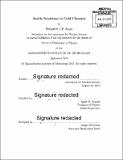Sterile neutrinos in cold climates
Author(s)
Jones, Benjamin J. P
DownloadFull printable version (63.35Mb)
Other Contributors
Massachusetts Institute of Technology. Department of Physics.
Advisor
Janet M. Conrad.
Terms of use
Metadata
Show full item recordAbstract
Measurements of neutrino oscillations at short baselines contain an intriguing set of experimental anomalies that may be suggestive of new physics such as the existence of sterile neutrinos. This three-part thesis presents research directed towards understanding these anomalies and searching for sterile neutrino oscillations. Part I contains a theoretical discussion of neutrino coherence properties. The open-quantum-system picture of neutrino beams, which allows a rigorous prediction of coherence distances for accelerator neutrinos, is presented. Validity of the standard treatment of active and sterile neutrino oscillations at short baselines is verified and non-standard coherence loss effects at longer baselines are predicted. Part II concerns liquid argon detector development for the MicroBooNE experiment, which will search for short-baseline oscillations in the Booster Neutrino Beam at Fermilab. Topics include characterization and installation of the MicroBooNE optical system; test-stand measurements of liquid argon optical properties with dissolved impurities; optimization of wavelength-shifting coatings for liquid argon scintillation light detection; testing and deployment of high-voltage surge arrestors to protect TPC field cages; and software development for optical and TPC simulation and reconstruction. Part III presents a search for sterile neutrinos using the IceCube neutrino telescope, which has collected a large sample of atmospheric-neutrino-induced events in the 1-10 TeV energy range. Sterile neutrinos would modify the detected neutrino flux shape via MSW-resonant oscillations. Following a careful treatment of systematic uncertainties in the sample, no evidence for MSW-resonant oscillations is observed, and exclusion limits on 3+1 model parameter space are derived. Under the mixing assumptions made, the 90% confidence level exclusion limit extends to ... , and the LSND and MiniBooNE allowed regions are excluded at >99% confidence level.
Description
Thesis: Ph. D., Massachusetts Institute of Technology, Department of Physics, 2015. Cataloged from PDF version of thesis. Includes bibliographical references (pages 313-339).
Date issued
2015Department
Massachusetts Institute of Technology. Department of PhysicsPublisher
Massachusetts Institute of Technology
Keywords
Physics.